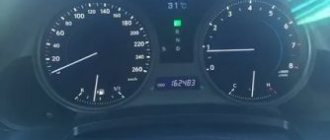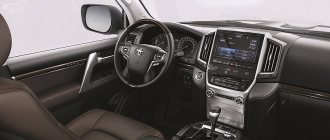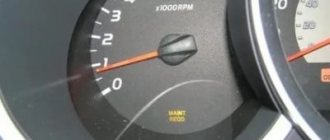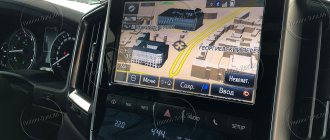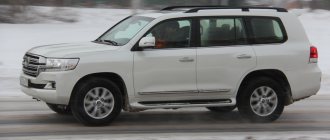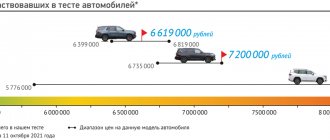Operating principle of the VSC system
Typically, sharp turns of the steering wheel in driving practice are used in exceptional cases when it is necessary to avoid a collision with another vehicle or a collision with an obstacle/pedestrian. If the track is dry and the tires have sufficient tread depth, this should not be a problem. But on a slippery road, such actions usually lead to skidding and leaving the straight path. Not all drivers manage to regain control of the car in such situations, which usually leads to the car turning around and causing an emergency situation.
The VSC system is designed to prevent skidding by blocking wheel rotation on the side opposite to the motion vector. Taking control over herself, she is able to correct the driver’s mistakes, allowing her to complete the maneuver she started, as if the road were not slippery.
Let us consider the kinematics of lateral slip. Centrifugal force when cornering at relatively high speeds causes the rear of the car to accelerate in the opposite direction of the corner. If the adhesion of the tires to the road surface is good, the friction force prevents the rear of the car from skidding. But if the speed of the car has exceeded a certain threshold, or if the road is slippery (water, snow, ice crust), the magnitude of the centrifugal force turns out to be greater than the adhesion force. In this case, the rear of the car begins to fall to the side, despite the fact that the steering wheel has already been returned to the position in which the wheels are pointing straight ahead.
The car does not start and the check vsc light is on
Toyota land cruiser prado 150
If the Toyota engine does not start and the Check light comes on along with the VSC Sysytem, then experts advise checking the battery. It is possible that the reason is a discharging battery.
You should check the battery using a multimeter. This is done as follows:
- Turn the multimeter knob to the “V” parameter.
- Touch the terminal with one probe of the device.
- For others - to the body.
If there is no voltage and the device does not show anything, then check the current strength in the battery:
- Turn the knob to parameter “A” and set the value to no more than 10A/h.
- Turn off the engine. Remove the keys from the ignition.
- Touch the positive terminal with one probe, and the negative terminal with the other.
- At rest, the indicator should stop at 0.07 mA. If more, then there is a leak somewhere. This may cause the battery to drain slowly.
If the battery cannot be restored, then it is better to purchase a new one.
How to fix parking sensor error
Another common problem with the Land Cruiser is parking sensors. This is a device that notifies the driver of the approaching obstacle: stone, curb, fence and others.
If the parking check light on the Kruzak 200 comes on, you need to check the following elements:
- Wires. They may become pinched or even break.
- A sensor that notifies you of an obstacle during parking. It may not be secured correctly.
- Short circuit in the system.
- Manufacturing defects.
To determine how good the Land Cruiser 200 parking sensors are, you need to do the following:
- Run the engine idle.
- Touch each sensor with your finger.
- If it is operational, it will begin to vibrate. If the device is silent, it is out of order.
Experts advise immediately contacting a service station. Here they will carry out all the necessary tests and replace the failed element.
In order for the parking sensor to work for a long time, it must be monitored:
- wipe away dirt and dust;
- check the tape for contamination if the sensor is electromagnetic;
- Clean the control unit every six months.
If errors occur, do not reset them and continue to operate the car as before. Each light indicates some kind of problem with the car, and only in rare cases do they light up due to an accidental failure in the electronics. In any case, it is difficult to determine what is broken without scanning. If you take care of your car and respond to errors that appear in a timely manner, eliminating them, you can extend the life of the vehicle for many years.
Troubleshooting
How to buy a Toyota Land Cruiser Prado 120
The appearance of the 4lo designation may be a symptom of a complex disorder. It’s like a pain syndrome in a person, which is pointless to suppress with pills - in this case, by disconnecting the battery terminal or resetting errors. Problems will appear again soon. It is necessary to eliminate the immediate cause of its occurrence.
Ignoring the problem will ultimately lead to either an unexpected stop of the car along the way, or to severe disruption of the operation of the fundamental components of the car - the engine or gearbox. Such breakdowns will already result in much larger monetary and time costs than timely diagnosis, identification of the problem and its elimination before the appearance of associated unpleasant and expensive problems.
Carrying out diagnostics, and even more so eliminating an error such as 4lo, without knowledge of the operation of the differential, gearbox or motor, as well as their electrical systems, is unsafe for the operation of the machine. Savings can result in large costs. Therefore, it is better to entrust repairs to professionals who have at their disposal the necessary electronic equipment, software and suitable tools for working with the machine.
Troubleshooting
To troubleshoot problems, you need to visit a technical service center or an authorized dealer. There they will conduct a check and computer diagnostics. Reading the error code will help determine the cause of the malfunction.
Frequent reasons for the VSC TRC off CHECK indicator lights to operate in the Prado 120:
- low fuel quality;
- faulty ABS (Antiblock Brake System) sensor;
- damaged wiring leading to the ABS sensor;
- engine weight;
- generator malfunction;
- liquid ingress or moisture accumulation in the fuse box (under the hood or in the passenger compartment).
Error value VSC TRC off CHECK
VSC TRC - warning light, indicates a problem in one of the control systems:
- traction force;
- vehicle stability;
- assistance during descent;
- assistance when starting on an incline.
The light signals turn on when the ignition key is turned to the “ON” position and go out after a few seconds.
They may light up for a minute after turning the ignition key, when the brake pedal is pressed again. It is normal if they go out after a while.
If the normal brake works when you press the pedal, you can continue driving.
VSC OFF - indicator of disabling the exchange rate control system. When the ignition is turned on, it lights up for a short period of time, then goes out. Lights up when the stability control system is turned off or the center differential is turned on.
If the indicator comes on, take the vehicle to a Toyota dealer.
CHECK ENGINE - “check engine” indicator. When you turn the key in the ignition switch, it lights up for 2-3 seconds, then goes out. Notifies the driver that the automatic transmission and engine control system have been checked.
The indicator turns on while driving in the following cases:
- completely empty fuel tank;
- if the fuel filler cap is lost;
- in case of problems with the engine and automatic transmission ESU.
If VSC OFF and the check light are on in the Prado 120, you need to go to a service station and carry out diagnostics.
Car scanners
Land Cruiser diagnostics should be carried out using proven devices. We are talking about scanners:
- Scan Tool Pro;
- Launch CReader V+;
- Delphi DS150E.
ScanToolPro is a budget scanner option for reading Land Cruiser 200 error codes. The device scans in real time the operation of all sensors. The scanner is suitable for displaying data on a smartphone screen, which can be conveniently mounted on the panel.
Automotive scanner Scan Tool Pro
pros:
- compatibility;
- protection against on-board computer failure;
- wide range diagnostics;
- Software in Russian;
- regular updates;
- 12 month warranty.
The downside is that when buying it is easy to run into a fake.
Launch CReader V+ features a bright LCD screen, eliminating the need to connect to a computer or smartphone. In addition to the OBDII protocol, the device is supplemented with another one (CAN data bus), which increases the functional component.
Automotive scanner Launch CReader V+
pros:
- autonomy;
- real-time scanning;
- user-friendly interface;
- increased resource;
- The test results are displayed in the form of text or graphics.
The downside is that for a number of owners of the Land Cruiser SUV, the device screen is too small.
Delphi DS150E is an impressively sized (noted as a disadvantage) reading device. The advantages are increased functionality, adequacy for many car models (including Land Cruiser), availability of a memory card for recording and storing codes.
Car scanner Delphi DS150E
Used Lexus GS III: air conditioning compressor jokes and a garland of errors
It’s even somehow scary to cut down the truth. “Lyokha” has a lot of fans and fanatics; I won’t have time to blink – I’ll have to fight off offers to “go under the bridge.” But I'll take the risk. Therefore, today we’ll talk about what can happen (but will not necessarily happen) with the body, interior and chassis of a used Lexus GS III, and then we will tell you what can break (but will not necessarily break) in the engines and gearboxes of this car. Have you noticed how delicate I am today?
Business class from the East
The GS appeared in the Lexus lineup in 1991, just two years after the appearance of the brand itself. By 2005, there had been two generations of GS, which were remembered for their Italian design, powerful engines, including the legendary JZ/UZ, and excellent quality. Well, and a whole stack of awards, especially from American magazines.
The third GS appeared in 2005 and was produced until 2011 with a slight restyling in 2008. And it was remembered primarily for its departure from the canons. It would be nice to have a hybrid version, influenced by fashion and time. Much more unexpected was the abandonment of in-line sixes and the introduction of optional all-wheel drive. Otherwise, it was just a modern business class with all the indispensable attributes in the form of an excellent interior, an optical instrument panel, adaptive gas-discharge light, LED interior lighting, a bunch of pillows and belt pretensioners even in the back row of seats.
The choice of options and trim levels was not shockingly diverse. The body is only a sedan, the engines are exclusively gasoline (powerful and even more powerful), the transmission is only automatic. True, even the basic package turned out to be rich.
Lexus GS 300 (S190) '2005–08
The car’s reputation turned out to be enviable, which is clearly visible from the prices on the secondary market. While the main competitors were falling in price with terrible force, the Lexus GS held on to the last. There have been anecdotal cases where a five-year-old car cost only 30 percent less than a new one. At the same time, it remained very liquid. Especially in the east of the country. If in the European part the car had strong competitors, then to the east of the Urals they simply turned a blind eye to real and imaginary shortcomings, and they were simply afraid of European cars.
True, they were not very willing to buy the new GS. Demand was satisfied by the import of used cars from the USA, which was very profitable in the years of the “low dollar”, and good reliability reduced risks to almost a minimum. And cars with two hundred thousand kilometers on them usually looked and drove like new, just like a Toyota or Lexus should. But the fact that the interior is a little rustic and the habits are worse than that of a Mercedes is not noticeable from the outside, and by and large, there are few subtle connoisseurs, and these small shortcomings went unnoticed.
Lexus GS 300 (S190) '2005–08
Unfortunately, there are rumors that something is not so right with the car. There is some kind of “PPC” going on (looking ahead: PPC is the problem of the fifth cylinder, which we will talk about in the second part of the review), mileage seems to be running out mercilessly, and prices for the GS are now still higher than for competitors. Is this car worth the premium?
Body
Externally, GS bodies, even of the first releases, are usually close to ideal. Even though the factory paint layer is thin and easily scratched.
The main places where chips and scratches appear are quite standard: the edge of the hood, the leading edge of the roof, the fenders around the headlights, the area around the door handles, the rear door opening at the bottom, the edges of the wheel arches and the rear edge of the rear arch.
Finding external corrosion will be difficult. If you want to fully assess the condition of the body, you will have to look under the bottom or remove a bunch of plastic parts. At a minimum, thresholds and lockers. The chances of finding visible corrosion in these hidden areas are already quite high if we are talking about cars more than six to eight years old.
Lexus GS 450h (S190) '2006–08
The area at the rear of the threshold is very vulnerable, where dirt accumulates on the bottom of the plastic protection, and there may be red marks on the seams. A thick layer of sealant below the rear door opening and above the threshold is also a potentially dangerous place. The seam of the spar and the rear floor is vulnerable in the recess between the plastic boot of the bottom and the spar itself.
Any impacts on the rear wing will most likely lead to depressurization of the seams, and in the triangle above the front edge of the arch and in the rear part, the corrosion process will begin in the internal cavities. Similar problems will arise if, under the locker, surface corrosion of the leading edge of the arch reaches the joint sealant.
Unfortunately, there are a lot of internal cavities that are not protected by anything other than paint. At the front, if the locker does not fit well to the fender, dirt collects on the amplifier's gusset between the body pillar and the upper front member. In addition to the surface rust on the weakly painted boot of the engine compartment, which is not scary, the welds of the front end, which are very important for the design, suffer.
Lexus GS 450h (S190) '2006–08
In the trunk, you need to remove the rear panel trim. Here, due to an unsuccessful design, the panel corrodes at the points of contact with the plastic. Sometimes severe surface corrosion appears under the rear bumper in the sandblast area from the rear wheels.
The windshield frame is also very vulnerable to corrosion. Especially in its upper part, starting from the side welds and slightly lower along the racks and along the entire upper plane of contact with the glass. Externally, the problem manifests itself only in the later stages, when rust appears from under the molding. Most likely, the initiator of the problem is the glass plywood and the low level of anti-corrosion treatment of this part, combined with installer errors and the high load on this seam when the body is bending. On cars with original glass, corrosion is usually minimal, pitted and without the formation of a loose surface.
As I already said, the body requires careful inspection in hidden areas. It has a number of potentially dangerous hidden points, and the excellent condition of the external panels means nothing. And if there are traces of accidents, then the body requires a mandatory check of all seams under the plastic and in the engine compartment. It is desirable that the car undergoes additional anti-corrosion treatment of hidden cavities and does not have damage to the protective plastic panels on the bottom and in the arches. Corrosion, invisible from the outside, will certainly manifest itself over time.
Lexus GS 430 (S190) '2005–08
The headlights are very worn on the outside, and the lens reflector on the inside is very burnt out. But even with the AFS system, the headlights work reliably.
The plastic under the windshield and mirrors also sometimes require repairs or replacement.
The bottom of the car is well protected by plastic boots, but the boots of the engine compartment and automatic transmission are easily damaged. This does not lead to fatal consequences, but the aerodynamics are disrupted.
Thresholds and floors covered with plastic right up to the floor rails are good. But if there are breaks in the plastic covers and the drainage holes are clogged, this protection will begin to work against the body.
Salon
Unfortunately, age makes itself felt much more strongly in the interior than in the appearance of the car. By two hundred thousand kilometers, the seats seriously sag, the coating on light leather suffers greatly, the steering wheel shines or is already peeling off, and the appearance of the floor covering noticeably deteriorates. In addition, on the back right it is often damaged to the point of holes. I note that there are practically no serious breakdowns here, and worn elements can be replaced and repaired.
Lexus GS 450h (S190) '2006–08
A touchscreen that doesn't work at the top is common, but it is replaced separately from the screen and is inexpensive. Worn decorative door sill trims can be tinted or replaced.
The climate system is, in principle, reliable, and failures most often occur due to a dirty smog sensor, which turns on recirculation, and due to the air conditioning compressor. It is on this generation of machines with direct drive, the so-called variable displacement compressor. It does not have a release clutch and operates in winter and summer, but in the “off” state the stroke of its pistons is only a few millimeters. And even in this mode, the mechanics still wear out a little. By the mileage of 180-200 thousand, the Teflon coating of the drive disk usually ends, and problems with wear of the pistons themselves begin. If you miss the oil and freon levels, you can expect the compressor liner to scuff. If the drive disk or pistons jam, the release clutch may break.
If the compressor is still spinning, then you can replace it, but this will not help for long. But you shouldn’t put it on epoxy: a jammed compressor can either bend the shaft, or break the drive belt and unscrew the fastener. Moreover, it is possible that together with a piece of the cylinder block.
Lexus GS 450h (S190) '2008–09
Sometimes the compressor breaks down gently - the control valve fails. But in any case, in a non-specialized service, if it breaks down, they will insist on replacing the entire unit: compressors with a permanent connection have gained the reputation of being unrepairable. By the way, the air conditioner’s drainage may also be clogged.
Even with a slight jamming of the mechanisms, weak gears of the hatch drive may be cut off.
The rear curtain also breaks regularly, and it is already difficult to find it in good condition during disassembly; you will have to order a “contract”. Usually the problem also lies in the drive gearbox on one side.
Failures of cushions and seats are relatively common. It takes a long time to treat them: the specialists of average services do not even suspect that there are belt tensioners and wiring to them in four places. In addition, there is an optional driver's knee airbag, which does not have a very reliable connector, and there are seat position sensors that are responsible for the level of inflation of the airbag. Universal scanner software usually cannot figure out these errors.
Lexus GS 300 (S190) '2008–12
Automatic transmission selector failures should be checked in the manual shift position - standard modes are activated reliably.
Otherwise, all interior systems are designed as simply as possible and therefore quite reliable. There are no software failures, strange glitches or the need for software updates. True, the music and navigation are not advanced, but the optional Mark Levinson sounds at least good.
Electrical and electronics
There are few electrical problems, but the paranoia of VCS errors will have to be fought regularly. They come out for any reason, and if there is no experienced electrician, then the “garland” will be a frequent occurrence.
After three hundred thousand mileage, it may be necessary to repair the generator, which rarely lasts longer. And in the absence of an engine compartment boot, it causes constant failures.
The machine is very sensitive to supply voltage, and if the voltage is insufficient, the engine control system will malfunction. At the first sign of problems, you need to change the relay regulator.
Lexus GS 300 (S190) '2008–12
Errors in ABS sensors and even failures of the unit itself are quite common and are often confused with VCS errors. Indeed, an error in the stabilization system with a lighted engine “check” appears regularly. Problems often lie outside the brake system itself - for example, in the tank ventilation system, lambda sensors or somewhere else.
Motors are sensitive to the condition of lambdas and mass air flow sensors, but the former are inexpensive, and the latter are easy to clean. They can be restored even after 300 thousand mileage.
Ignition coils suffer due to oil leaks in the engine, and after working in oil in the middle of the “leg”, repair kits no longer save the situation.
Quite a lot of problems are caused by various anti-theft devices. The standard alarm system is not capable of anything at all, and both car thieves and owners know this. So combinations of three “signals” and glitches from each, multiplied by the installer’s crooked hands, are a common thing.
Lexus GS 300 (S190) '2008–12
